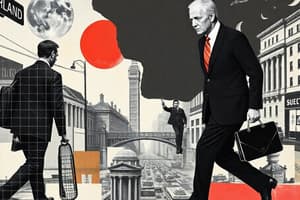Podcast
Questions and Answers
What is one of the main objectives of regulations?
What is one of the main objectives of regulations?
- To protect consumers from financial harm (correct)
- To reduce competition
- To eliminate all regulations
- To promote monopolies
Regulations are only necessary at the national level.
Regulations are only necessary at the national level.
False (B)
Name one reason why regulations are needed.
Name one reason why regulations are needed.
To protect individual rights and general safety.
Regulations help protect the safety of individuals from __________ caused by business practices.
Regulations help protect the safety of individuals from __________ caused by business practices.
Which of these is a regulation that typically exists?
Which of these is a regulation that typically exists?
Match the following regulations with their purposes:
Match the following regulations with their purposes:
Market forces alone are sufficient to regulate firms effectively.
Market forces alone are sufficient to regulate firms effectively.
What can excessive centralised regulation prevent?
What can excessive centralised regulation prevent?
What is the primary goal of the FCA regarding market abuse?
What is the primary goal of the FCA regarding market abuse?
Competition can potentially lead to better pricing for consumers.
Competition can potentially lead to better pricing for consumers.
What must firms do to maintain transparency in the market?
What must firms do to maintain transparency in the market?
Anti-trust laws are important in __________ sectors.
Anti-trust laws are important in __________ sectors.
Match the following terms with their descriptions:
Match the following terms with their descriptions:
What is a potential downside of too much competition?
What is a potential downside of too much competition?
Regulators want firms to be misleading in their interactions with consumers.
Regulators want firms to be misleading in their interactions with consumers.
What are the benefits of competition according to the content?
What are the benefits of competition according to the content?
What has impacted both traditional and digital stock markets recently?
What has impacted both traditional and digital stock markets recently?
A bailout for companies in crisis is likely in the current economic situation.
A bailout for companies in crisis is likely in the current economic situation.
What global situation is contributing to energy market instability?
What global situation is contributing to energy market instability?
The energy market stability is essential for sustainable economic activity and __________________.
The energy market stability is essential for sustainable economic activity and __________________.
Match the energy-related issues with their impacts:
Match the energy-related issues with their impacts:
Which country's actions have contributed to the current energy crisis?
Which country's actions have contributed to the current energy crisis?
The energy demands have decreased following the COVID-19 pandemic.
The energy demands have decreased following the COVID-19 pandemic.
What might the rapid global recovery from COVID-19 lead to in terms of energy supply?
What might the rapid global recovery from COVID-19 lead to in terms of energy supply?
What is the primary purpose of telecommunications?
What is the primary purpose of telecommunications?
Telecommunications played a minimal role during the COVID-19 pandemic.
Telecommunications played a minimal role during the COVID-19 pandemic.
What are two objectives of regulating the telecommunications industry?
What are two objectives of regulating the telecommunications industry?
The EU Roaming Regulation ended _____ charges for Europeans traveling within the EU.
The EU Roaming Regulation ended _____ charges for Europeans traveling within the EU.
Match the regulatory objectives with their descriptions:
Match the regulatory objectives with their descriptions:
What role does competition play in the telecommunications market?
What role does competition play in the telecommunications market?
The financial services markets in the UK and US are not heavily regulated.
The financial services markets in the UK and US are not heavily regulated.
Name a social factor that influences regulatory frameworks.
Name a social factor that influences regulatory frameworks.
What triggered the global liquidity crisis or ‘credit crunch’?
What triggered the global liquidity crisis or ‘credit crunch’?
The collapse of Lehman Brothers in September 2008 is considered a key event in the credit crunch.
The collapse of Lehman Brothers in September 2008 is considered a key event in the credit crunch.
What significant action was taken by the UK government in February 2008 to restore consumer confidence in the banking system?
What significant action was taken by the UK government in February 2008 to restore consumer confidence in the banking system?
The US agreed to a $______ billion rescue package for its financial services sector in October 2008.
The US agreed to a $______ billion rescue package for its financial services sector in October 2008.
Match the following events with their corresponding dates:
Match the following events with their corresponding dates:
Which bank was the first sign of a loss of confidence in the UK banking sector?
Which bank was the first sign of a loss of confidence in the UK banking sector?
The credit crunch primarily affected only the UK banking sector.
The credit crunch primarily affected only the UK banking sector.
Which four countries received bailouts from the EU between 2010 and 2012?
Which four countries received bailouts from the EU between 2010 and 2012?
What was the primary focus of Zucman's statement regarding the release of leaked documents?
What was the primary focus of Zucman's statement regarding the release of leaked documents?
The Danske Bank scandal involved the flow of €200 million through its Estonian branch.
The Danske Bank scandal involved the flow of €200 million through its Estonian branch.
What were the main consequences faced by Danske Bank following the money laundering scandal?
What were the main consequences faced by Danske Bank following the money laundering scandal?
The CEO of Danske Bank was charged with ________ his responsibilities.
The CEO of Danske Bank was charged with ________ his responsibilities.
What was the fate of Patisserie Valerie after the discovery of the secret accounts?
What was the fate of Patisserie Valerie after the discovery of the secret accounts?
The Trade and Cooperation Agreement was finalized after the UK left the EU on 31 December 2019.
The Trade and Cooperation Agreement was finalized after the UK left the EU on 31 December 2019.
What did the Danish authorities do in response to the Danske Bank scandal?
What did the Danish authorities do in response to the Danske Bank scandal?
Flashcards
What are laws?
What are laws?
Rules that bind all members of a community or society, protecting their safety and rights. Examples include food safety, speed limits, and employee protection laws.
What is regulation?
What is regulation?
Laws implemented to protect individuals and organizations from harm caused by business practices. Examples include financial regulations that protect consumers from financial harm.
What is self-regulation?
What is self-regulation?
The idea that market forces naturally guide businesses towards ethical practices, reducing the need for extensive government intervention. This concept argues that businesses are incentivized to act responsibly to maintain customer trust and profitability.
What is the argument against regulation?
What is the argument against regulation?
Signup and view all the flashcards
Why are consumer and investor protections crucial in finance?
Why are consumer and investor protections crucial in finance?
Signup and view all the flashcards
What are examples of regulatory failures?
What are examples of regulatory failures?
Signup and view all the flashcards
What are new developments in regulation?
What are new developments in regulation?
Signup and view all the flashcards
What are the 'lessons' for the future of regulation?
What are the 'lessons' for the future of regulation?
Signup and view all the flashcards
Energy Market Instability
Energy Market Instability
Signup and view all the flashcards
Energy Crisis
Energy Crisis
Signup and view all the flashcards
Global Energy Demand and Supply Chain
Global Energy Demand and Supply Chain
Signup and view all the flashcards
Increased Energy Demand
Increased Energy Demand
Signup and view all the flashcards
Energy Supply Chain Disruptions
Energy Supply Chain Disruptions
Signup and view all the flashcards
Transition to Greener Energy
Transition to Greener Energy
Signup and view all the flashcards
Conflicting Price Objectives
Conflicting Price Objectives
Signup and view all the flashcards
Geopolitical Uncertainty
Geopolitical Uncertainty
Signup and view all the flashcards
Market Abuse Deterrence
Market Abuse Deterrence
Signup and view all the flashcards
Benefits of Fair Competition
Benefits of Fair Competition
Signup and view all the flashcards
Anti-trust Laws
Anti-trust Laws
Signup and view all the flashcards
The Downside of Excessive Competition
The Downside of Excessive Competition
Signup and view all the flashcards
Innovation in Finance
Innovation in Finance
Signup and view all the flashcards
Transparent Markets
Transparent Markets
Signup and view all the flashcards
Publishing details of Activities
Publishing details of Activities
Signup and view all the flashcards
Market Integrity
Market Integrity
Signup and view all the flashcards
Stakeholder Understanding
Stakeholder Understanding
Signup and view all the flashcards
Self-Regulation
Self-Regulation
Signup and view all the flashcards
Regulatory Failure
Regulatory Failure
Signup and view all the flashcards
Contextual Factors in Regulation
Contextual Factors in Regulation
Signup and view all the flashcards
Regulatory Objectives
Regulatory Objectives
Signup and view all the flashcards
Analyzing Regulatory Frameworks
Analyzing Regulatory Frameworks
Signup and view all the flashcards
Dynamic Regulation
Dynamic Regulation
Signup and view all the flashcards
Global Laundromat
Global Laundromat
Signup and view all the flashcards
Offshore Financial Centers
Offshore Financial Centers
Signup and view all the flashcards
Howard Wilkinson
Howard Wilkinson
Signup and view all the flashcards
Consumer & Investor Protections in Finance
Consumer & Investor Protections in Finance
Signup and view all the flashcards
Consequences of Financial Scandals
Consequences of Financial Scandals
Signup and view all the flashcards
Money Laundering
Money Laundering
Signup and view all the flashcards
Whistleblowing
Whistleblowing
Signup and view all the flashcards
Brexit
Brexit
Signup and view all the flashcards
What led to the reluctance of banks to lend to each other?
What led to the reluctance of banks to lend to each other?
Signup and view all the flashcards
What caused the global liquidity crisis?
What caused the global liquidity crisis?
Signup and view all the flashcards
How did the reluctance of banks to lend each other affect customers?
How did the reluctance of banks to lend each other affect customers?
Signup and view all the flashcards
What sparked the credit crunch?
What sparked the credit crunch?
Signup and view all the flashcards
What event in the UK served as an early warning sign of the credit crunch?
What event in the UK served as an early warning sign of the credit crunch?
Signup and view all the flashcards
What were some of the consequences of the credit crunch?
What were some of the consequences of the credit crunch?
Signup and view all the flashcards
How did the credit crunch impact countries outside of the US and UK?
How did the credit crunch impact countries outside of the US and UK?
Signup and view all the flashcards
What did the failures of banks in Iceland and Cyprus suggest about the financial system?
What did the failures of banks in Iceland and Cyprus suggest about the financial system?
Signup and view all the flashcards
Study Notes
ICA International Advanced Certificate in Governance, Risk and Compliance Course Manual - Module 1
- The course manual focuses on the knowledge and understanding needed for recognizing the reasons industries are regulated.
- It explores what regulation intends to achieve, who it intends to achieve this for, and what influences have shaped its development over time.
- A deeper investigation into the practicalities of regulation is examined in Unit 2.
- The module also reviews governance, risk and compliance (GRC): what it is, why the component elements are important, and how they interact to build controls within an organization.
- Laws are rules that bind members of a community, ensuring safety, and protecting rights. They exist at local, national, and international levels.
Unit 1: Why Do We Have to Do What We Do?
- Objectives of the unit include analyzing the reasons for regulations, describing regulatory objectives, identifying regulatory objectives in a specific sector, summarizing the factors shaping regulations, examining why consumer and investor protection are crucial in financial services, and identifying new regulatory developments reflecting future trends.
- Laws on food safety, speed limits, professional licensing, and environmental protections are examples of regulations.
- Regulations protect individuals from discrimination and harm from business practices.
- "Information asymmetry" occurs in financial services where consumers lack the information to fully understand complex products.
Unit 1.1: The Rationale for Regulation
- Regulation in financial services is justified by the need for consumer protection, as consumers often lack the knowledge and skills to evaluate the financial position of firms.
- Financial products are often intangible, unlike physical goods; making it challenging for consumers to evaluate their potential financial gain.
- Market forces alone cannot fully self-regulate, and regulation is important for the sustainability of the financial sector.
- Oversights in regulation can lead to systemic financial failures with far-reaching effects.
Unit 1.2: Counter Arguments against Regulation
- Regulations can increase the cost of products and services, making them less competitive.
- Regulation can also act as a barrier to entry for new firms, reducing competition.
- Regulation sometimes restricts diversification and innovation within industries
Unit 1.2:Objectives of Regulation
- The International Organization of Securities Commissions (IOSCO): established in 2003, outlines three core objectives of securities regulation: investor protection, maintaining fair, efficient, and transparent markets, and reducing systemic risk.
- Regulations vary by jurisdiction, although the core aims are generally similar.
Unit 1.3: Maintaining Confidence in Markets
- Market confidence is the foundation for a stable financial system, impacting broader economic interests.
- Losses of confidence can happen rapidly in markets and can trigger crises and collapses of major institutions with cascading effects on other firms and the wider economy.
- The examples of Lehman Brothers (2008) and Fannie Mae/Freddie Mac (2008) highlight the risks in the mortgage market and the importance of regulation.
- Scandals and failures can lead to a loss of trust and confidence in the systems surrounding a sector.
Unit 1.4: Systemic Risk and Market Integrity
- Market stability is a vital aspect of regulatory objectives as failures can spread and cause substantial damage to a global economy. The examples of the 2008 credit crisis and the sub-prime mortgage market, as well as recent global events and the COVID-19 pandemic illustrate how interconnected markets can be.
- Maintaining confidence and stability in markets are critical for continued economic activity as well as consumer protection.
Unit 1.5: Competition, Innovation and Transparency
- Promoting competition can improve choice for consumers and foster innovation.
- Regulating monopolies, excessive pricing, and unethical conduct by firms is important.
- Transparency in market operations is essential for fair competition.
Unit 1.6: Market Abuse and Financial Crimes
- Market abuse undermines market integrity, and this can range from insider dealing to market manipulation.
- Financial crime, like money laundering and fraud, is regulated to protect the integrity of markets.
- Laws and enforcement measures are key to deter and track these crimes.
Unit 2: The Regulatory Timeline
- Provides a historical overview of regulatory developments (e.g., 1929 Wall Street Crash, 1988 Basel Accord, 2008 financial crisis, etc.) and their impacts on the financial sector.
- Focuses on the factors that influence the form and direction of regulation over time.
Studying That Suits You
Use AI to generate personalized quizzes and flashcards to suit your learning preferences.





